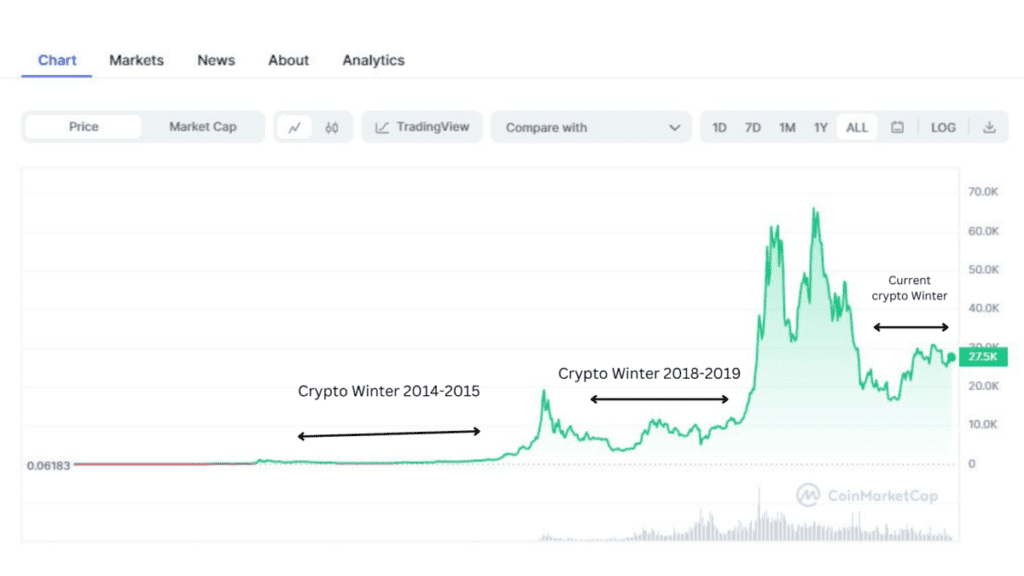There’s a term that sends shivers down the spines of crypto enthusiasts and investors alike: Crypto Winter.
This phrase isn’t about the chilly season but severe market downturns in the crypto space.

What is Crypto Winter?
Crypto Winter refers to prolonged bear markets in cryptocurrency, where the prices of digital currencies plummet, market activity slows down, and the enthusiasm of the previously buzzing crypto community fades into a quiet shiver.
Historical Context
The crypto realm has witnessed two significant winters so far. Each has left an indelible mark on the community, teaching hard lessons in resilience and adaptation.

First Crypto Winter (2014/15):
The first crypto winter occurred in 2014 and 2015, post the Mt. Gox disaster, which saw the biggest Bitcoin exchange go bankrupt due to a massive hack. Bitcoin’s price plummeted from over $1,000 to around $200.
Second Crypto Winter (2018/19):
The second was post the euphoria of late 2017 when Bitcoin and other cryptocurrencies reached their then-all-time highs, only to tumble down in 2018 and part of 2019.
The market corrected harshly, with Bitcoin tumbling from nearly $20,000 to just above $3,000.
Causes of Crypto Winter
A chilling mix of factors contributes to the onset of a crypto winter.
Market Saturation:
As more projects and coins flood the market, the competition becomes fierce, and not all can survive the icy grip of reality.
Regulatory Challenges:
The frosty relationship between crypto ventures and regulatory bodies often contributes to market downturns.
Loss of Investor Confidence:
Once trust melts away, it’s a slippery slope to a crypto winter.
Impact on Investors
The cold winds of crypto winter don’t blow gently on investors’ fortunes.
Financial Loss:
Many see their digital assets freeze in value or evaporate into thin air.
Emotional Toll:
The emotional strain can be harsh as dreams of financial freedom turn to ice.
How long do Crypto Winters usually last?
Crypto Winters, periods of prolonged decline in cryptocurrency prices, have historically varied in duration. According to charts, a Crypto Winter lasts 2 to 3 years. This was echoed by a case from early 2018 to late 2020, which lasted almost three years.
The duration can be unpredictable due to the volatile nature of the cryptocurrency market.
Surviving the Crypto Winter
Despite the bleak landscape, some strategies can warm the investor’s journey through crypto winter.
Diversification:
A well-diversified portfolio can be the cozy fireplace amidst the cold.
Long-Term Vision:
Keeping a long-term perspective can help navigate the icy trails of crypto winter.
Community Engagement:
Engaging with the crypto community provides warmth in shared experiences and collective learning.
What are the signs of a Crypto Winter ending?
The signs of a Crypto Winter ending can vary due to the cryptocurrency market’s highly volatile and unpredictable nature.
However, there are specific indicators and trends that investors and analysts often watch for as potential signals that a Crypto Winter might be nearing its end.
- Historical Precedent: Observing past trends and comparing them to the current market conditions could be indicative.
- Performance of Tech Stocks: There has been a noticeable correlation between the performance of tech stocks and cryptocurrencies. If tech stocks perform well, it could be a sign that the crypto market might follow suit.
- Recovery of Major Cryptocurrencies: When leading cryptocurrencies like Bitcoin recover to certain psychological price levels, it may be seen as a sign of recovery. For example, some saw Bitcoin’s price recovering above $30,000 in 2023 as a signal of the end of the Crypto Winter.
- Trading Levels: If crypto assets start trading near or above levels seen before major adverse events, it could signal the end of the Crypto Winter. For instance, trading levels recovering after a significant market event like the collapse of a major exchange could be a positive sign.
- Price Projections: Some analysts make price projections based on various factors. For instance, projections that Bitcoin could recover to $30,000 in the second half of 2023 could be seen as a sign of the Crypto Winter ending.
- Market Momentum: Observing the momentum in the cryptocurrency market can also provide clues. If there’s a positive momentum and increased trading volumes, it might indicate a thawing of the Crypto Winter.
Rebirth: Spring Following Winter
Post-winter, the crypto space often emerges stronger, wiser, and more robust, ready to blossom in the subsequent crypto spring.
Conclusion
Crypto Winter is a harsh yet formative period in the cryptocurrency domain. It tests the investors’ mettle, shakes out the weak hands, and eventually leads to a stronger, more resilient crypto community.
Recent Posts
A season you awaited probably more than Christmas if you are a true crypto holder is Altcoin Season. What is Altcoin Season? The term "altcoin season" refers to a time when alternative...
Another stablecoin that has been around for some time and gained trust is Binance's BUSD. What is BUSD? Binance USD (BUSD) is a stablecoin pegged to the US dollar and issued by Binance...
